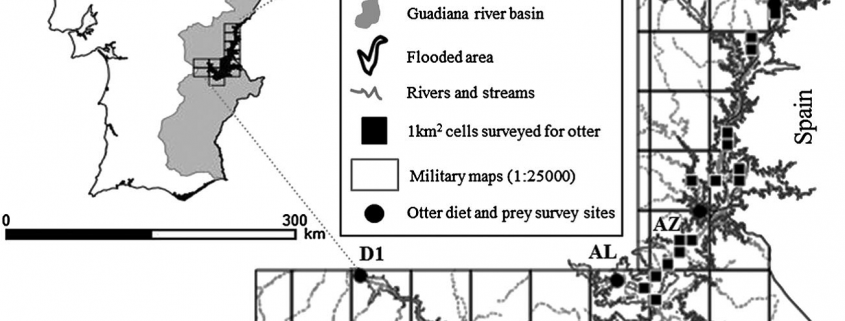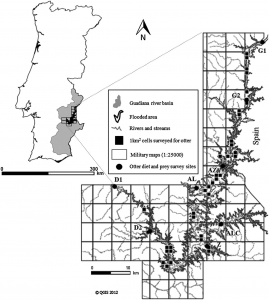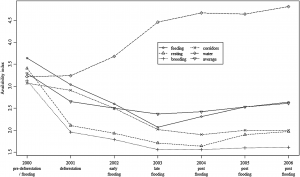The Impact of Dam Construction on Otters in Southern Portugal
by Hanover Matz, RJD Intern
Constructed between 1998 and 2003, the Alqueva Dam lies in south-eastern Portugal. Situated in the Guadiana River valley, construction of the dam flooded an area of 250 km2, creating the largest artificial lake in Europe. To determine the impact of this dam on the Eurasian otter (Lutra lutra), Pedroso et al. conducted a study across all phases of construction: pre-flooding, flooding, and post-flooding. The study focused on changes in otter distribution, otter diet and prey availability, and the availability of the main ecological requirements of otters, or what the otters need in a habitat to survive. Otters are apex predators in European fresh water food webs, and require connected river and stream habitats with specific bank structures to feed, reproduce, and thrive. Understanding the effects of human activities such as dam construction on river flow and otter ecology is important for conservation of both the otter species and its riverine habitat.
Surveys for the study were conducted across four main phases of the reservoir construction: pre-deforestation/flooding (2000), deforestation (2001), flooding (2002 and 2003) and post-flooding (2004 to 2006). This provided information not only on the effects of reservoir construction on otters throughout all parts of the process, but also long-term monitoring after the completion of the dam. The survey area of the reservoir and surrounding region was organized into a grid consisting of 25 km2 cells. In each cell, the survey teams searched for and recorded signs of otters present in the area. 39 1 km2 survey areas were then randomly selected within the flooded area and assessed as well. To determine changes in otter diet and prey availability, samples of otter spraints (feces) were searched for prey items and identified. Survey teams also collected prey animals in the local streams. Finally, the availability of otter ecological requirements was determined in each 1 km2 cell based on five qualifications: availability of prey and feeding areas, availability of resting sites, suitability for breeding, availability of corridors for movement, and accessibility to fresh water.
Over the course of the construction, the study found that the percentage of the area occupied by otters on the 25 km2 scale did not change significantly. The distribution of otters shifted throughout the region during the flooding phase, and on the 1 km2 scale there was a decrease in otters during the deforestation and flooding phases, with some recovery after completion of the project. Prey sampling showed that construction of the reservoir lead to a decrease in the numbers of different species of fish and crustaceans eaten by the otters, as well as a shift towards consumption of non-native species over native prey animals. Assessment of ecological availability showed that all qualifications decreased with the construction of the dam, except for accessibility to fresh water. This increased due to the establishment of the permanent reservoir rather than streams which may disappear during the dry season.
These results indicate that although creation of the Alqueva Reservoir may not have seriously impacted the numbers of otters in the region, it has caused a shift in how the otters feed and what ecological requirements are available to them. The shift to a consumption of less diversified prey animals and more non-native species indicates a change in the community of the fresh water habitats. Now that the rivers and streams have been replaced with a standing reservoir, better adapted non-native species of fish and crustaceans such as Procambarus clarkia, a crayfish from the U.S., may be outcompeting native species. Also, a shift in otter diet to smaller, non-native fish means the otters must eat more fish than before to maintain the same amount of biomass. Construction of the reservoir has also changed the habitat available to the otters. Flooding of the banks of rivers and streams has removed the holes and recesses the otters use for breeding, leaving only unsuitable rocky outcrops on the reservoir edges. Removal of shallow river banks also eliminates prime prey habitat and hunting grounds for the otter.
While the Alqueva Reservoir may still be able to support a stable population of Eurasian otters, it is possible that the same alterations to habitat in other areas may harm less dense populations. As stated by the authors, “[…] dams do not offer equal opportunities for otter populations compared with a network of rivers and streams.” These opportunities include access to prey, breeding sites, and corridors for movement from one habitat to another. This study shows the importance of conserving the appropriate habitat structures and qualities necessary for the otters to survive. It also has wide reaching applications to conservation across the world. Monitoring apex predators, whether they are otters in European rivers, lions on the African Serengeti, or sharks in the world’s oceans is an effective way to gauge the health of an ecosystem. If the top predators in a food web have drastically changed in numbers or behavior, it is likely that an ecological disturbance has occurred somewhere down the chain. To better assess the impact of human activities on the environment, studies such as this one are necessary for conservation and protection.
REFERENCE
Pedroso, Nuno M., Tiago A. Marques, and Margarida Santos‐Reis. “The response of otters to environmental changes imposed by the construction of large dams.” Aquatic Conservation: Marine and Freshwater Ecosystems (2013).






Leave a Reply
Want to join the discussion?Feel free to contribute!